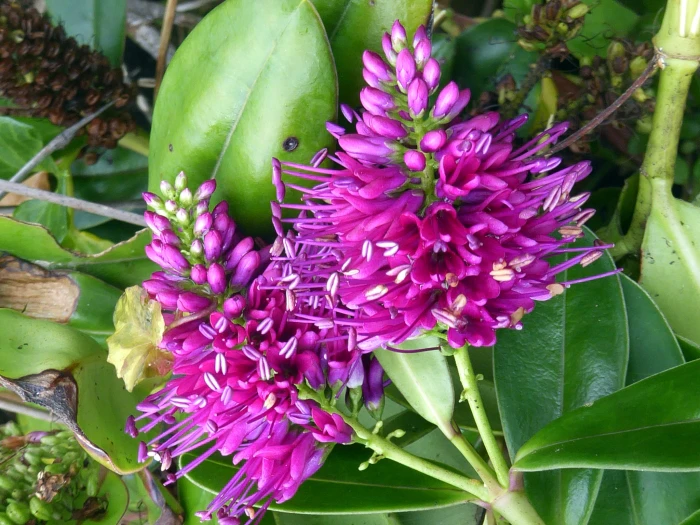Hebe
(Veronica speciosa)
Hebe (Veronica speciosa)
/
/

Peter de Lange
Public Domain
Image By:
Peter de Lange
Recorded By:
Copyright:
Public Domain
Copyright Notice:
Photo by: Peter de Lange | License Type: Public Domain | License URL: http://creativecommons.org/publicdomain/zero/1.0/ | Rights Holder: Peter de Lange | Publisher: iNaturalist | Date Created: 2017-04-14T13:39:58-07:00 |




































Estimated Native Range
Climate Requirements for Columbus, Mississippi
| This Plant | Your Site | Plant Suitability for Your Location | ||
|---|---|---|---|---|
| • Precipitation | 13" - 134" | 56" | Aquatic | Aquatic |
| • High Temp. | 62°F - 91°F | 92°F | Your summers may be too hot for this plant. | Too hot |
| • Low Temp. | 18°F - 59°F | 32°F | Your winter temperatures are normal for this plant | Excellent |
This plant should grow well at your location with about N inches per year (Y minutes per month) of irrigation.
Summary
Veronica speciosa, commonly known as Hebe, is an evergreen shrub native to the open woodlands and alpine regions of New Zealand. It typically reaches heights between one and two meters and is characterized by its dense, bushy form. The leaves of Veronica speciosa are dark green, glossy, and quite thick, usually measuring 2 to 5 centimeters long, which contributes to its lush appearance throughout the year. The inflorescence is up to 8 centimeters long and densely packed with pale pink to bright magenta flowers, each just under a centimeter wide with a short throat spreading into a four-lobed corolla. The flowering season extends from late spring to autumn, with the flowers being particularly showy and attractive to pollinators.
Veronica speciosa and its many cultivars and hybrids are highly valued for their lush evergreen foliage, showy flowerheads, long blooming season, and ease of cultivation. These plants are commonly used in gardens for border planting, as specimen plants, and in urban settings where their hardiness and ornamental value are appreciated. They can even be grown outdoors in sheltered parts of southern Britain. In cultivation, they perform best in full sun or part shade, with medium amounts of water, and in soils with medium drainage. While generally disease-resistant, they can be prone to root rot in poorly drained soils and may suffer from foliar diseases in humid conditions. It’s important to provide good air circulation around the plants to minimize these issues.CC BY-SA 4.0
Veronica speciosa and its many cultivars and hybrids are highly valued for their lush evergreen foliage, showy flowerheads, long blooming season, and ease of cultivation. These plants are commonly used in gardens for border planting, as specimen plants, and in urban settings where their hardiness and ornamental value are appreciated. They can even be grown outdoors in sheltered parts of southern Britain. In cultivation, they perform best in full sun or part shade, with medium amounts of water, and in soils with medium drainage. While generally disease-resistant, they can be prone to root rot in poorly drained soils and may suffer from foliar diseases in humid conditions. It’s important to provide good air circulation around the plants to minimize these issues.CC BY-SA 4.0
Plant Description
- Plant Type: Shrub
- Height: 1-3 feet
- Width: 1-3 feet
- Growth Rate: Moderate
- Flower Color: Purple, Pink
- Flowering Season: Spring, Summer, Fall
- Leaf Retention: Evergreen
Growth Requirements
- Sun: Full Sun, Part Shade
- Water: Medium
- Drainage: Medium
Common Uses
Bank Stabilization, Bee Garden, Bird Garden, Border Plant, Butterfly Garden, Deer Resistant, Groundcover, Hummingbird Garden, Low Maintenance, Rabbit Resistant, Salt Tolerant, Showy Flowers
Natural Habitat
Open woodlands and alpine regions of New Zealand
Other Names
Common Names: Showy Hebe, Showy-Speedwell, Titirangi, Napuka
Scientific Names: Hebe speciosa, Veronica speciosa, Veronica hendersonii, Veronica imperialis, Hebe imperialis, Veronica speciosa var. imperialis, Veronica kermesina, Veronica speciosa subsp. imperialis
GBIF Accepted Name: Veronica speciosa R.Cunn. ex A.Cunn.